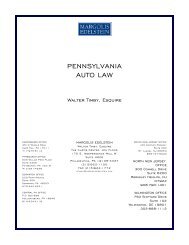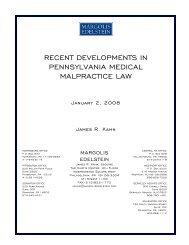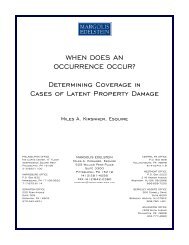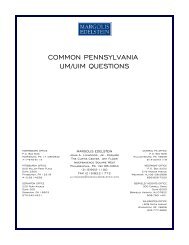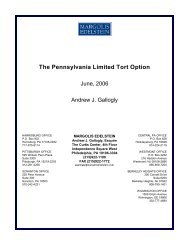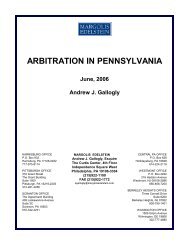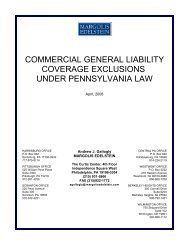selected topics in pennsylvania legal malpractice law - Margolis ...
selected topics in pennsylvania legal malpractice law - Margolis ...
selected topics in pennsylvania legal malpractice law - Margolis ...
You also want an ePaper? Increase the reach of your titles
YUMPU automatically turns print PDFs into web optimized ePapers that Google loves.
whom the defense is asserted must have had a full and fair opportunity to litigate the issues <strong>in</strong> the<br />
prior proceed<strong>in</strong>g. Alberici v. T<strong>in</strong>ari, 374 Pa. Super. 20, 542 A.2d 127 (1988), alloc. den’d, 534 Pa.<br />
625, 627 A.2d 730 (1993). Collateral estoppel applies even where the subsequent action differs<br />
from the orig<strong>in</strong>al suit. Murphy v. Landsburg, 490 F.2d 319 (3d Cir. 1973), cert. den’d, 416 U.S.<br />
939 (1974).<br />
DAMAGES IN LEGAL MALPRACTICE CLAIM<br />
In order to establish a claim of <strong>legal</strong> <strong>malpractice</strong>, a pla<strong>in</strong>tiff must demonstrate that the<br />
negligence of the attorney was the proximate cause of actual loss to the pla<strong>in</strong>tiff rather than only<br />
nom<strong>in</strong>al damages, speculative harm or the threat of future harm. Rizzo v. Ha<strong>in</strong>es, 520 Pa. 484, 555<br />
A.2d 58 (1989). Damages are considered remote or speculative only if there is uncerta<strong>in</strong>ty<br />
concern<strong>in</strong>g the identification of the existence of damages, not just the <strong>in</strong>ability to precisely calculate<br />
the amount or value of damages.<br />
Where the <strong>malpractice</strong> action stems from an underly<strong>in</strong>g litigation case, “[t]he orthodox view,<br />
and <strong>in</strong>deed virtually the universal one, is that when a pla<strong>in</strong>tiff alleges that the defendant <strong>law</strong>yer<br />
negligently provided services to him or her as a pla<strong>in</strong>tiff <strong>in</strong> the underly<strong>in</strong>g action, he or she must<br />
establish by the preponderance of the evidence that he or she would have recovered a judgment <strong>in</strong><br />
the underly<strong>in</strong>g action <strong>in</strong> order to be awarded damages <strong>in</strong> the <strong>malpractice</strong> action, which are measured<br />
by the lost judgment.” Williams v. Bashman, 457 F. Supp. 322 (E.D. Pa.1978). This often called<br />
proof of the case with<strong>in</strong> a case. “Proof of damages is as crucial to a professional negligence action<br />
for <strong>legal</strong> <strong>malpractice</strong> as is proof of the negligence itself.” Schenkel v. Monheit, 266 Pa. Super. 396<br />
405 A.2d 493 (1979). Accord, McCartney v. Dunn & Conner, Inc., 386 Pa. Super 563, 563 A.2d<br />
525 (1989) (disallow<strong>in</strong>g an award <strong>in</strong> a <strong>legal</strong> <strong>malpractice</strong> action based upon speculations regard<strong>in</strong>g<br />
settlement negotiations); Myers v. Robert Lewis Seigle, P.C., 751 A.2d 1182 (Pa. Super. 2000),<br />
app. denied, 795 A.2d 978 (Pa. 2000). The Court of Appeals for the Third Circuit once held that<br />
under Pennsylvania <strong>law</strong>, expert evidence may be sufficient for a jury to f<strong>in</strong>d that the pla<strong>in</strong>tiff would<br />
have been successful <strong>in</strong> the underly<strong>in</strong>g litigation, mak<strong>in</strong>g it unnecessary to recreate the prior trial<br />
with<strong>in</strong> a trial to prove damages <strong>in</strong> a <strong>malpractice</strong> action. Honeywell, Inc. v. Am. Standard Test<strong>in</strong>g<br />
Bureau, Inc., 851 F.2d 652 (3d Cir. 1988).<br />
Under Pennsylvania <strong>law</strong>, any lack of ability to collect damages <strong>in</strong> the underly<strong>in</strong>g action<br />
must be asserted as an affirmative defense by the attorney and affirmatively proven. The attorney<br />
must plead and prove that if the former client obta<strong>in</strong>ed a judgment <strong>in</strong> the underly<strong>in</strong>g case that<br />
noth<strong>in</strong>g or only a portion of it would have actually been paid because of <strong>in</strong>surance limits or assets<br />
of the defendant. The Pennsylvania Supreme Court recognized that a <strong>legal</strong> <strong>malpractice</strong> action is<br />
different from any other type of <strong>law</strong>suit because a pla<strong>in</strong>tiff must prove a case with<strong>in</strong> a case and<br />
establish that he would have recovered a judgment <strong>in</strong> the underly<strong>in</strong>g action. But the defendant must<br />
show the judgment could not have been collected. If lack of collectability can be shown then the<br />
client should be compensated only for actual losses and it would be <strong>in</strong>equitable for the pla<strong>in</strong>tiff to<br />
be able to obta<strong>in</strong> a judgment aga<strong>in</strong>st the attorney which is greater than the judgment that the pla<strong>in</strong>tiff<br />
could have collected from the third party. Kituskie v. Korbman, 552 Pa. 275, 714 A.2d 1027<br />
(1998).<br />
-7-



